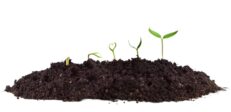Beneficial Mycorrhizal Fungi
Beneficial Mycorrhizal fungi form a mutually beneficial relationship with the root system of most plants. In such a relationship, both the plant and the fungi reap benefits. Unbelievably this beneficial relationship is thought to be at least 400 million years old. This makes this relationship one of the oldest known synergistic relationships.
Benefits of Mycorrhizae
The plant receives several important benefits from the Mycorrhizal fungi including:
- Enhanced root system. Every farmer and gardener knows that the most important part of the plant is the root system. With bigger, more developed roots you will get a healthier, more productive plant. In fact, mycorrhizal fungi can help roots absorb both more water and more nutrients.
- Increased Plant Strength and Plant Vigor. Plants are healthier and more vigorous when there is an abundance of mycorrhizal fungi in their soil.
- Better Soil Structure. Beneficial Mycorrhizal Fungi produce a compound called glomalin. This compound works much like glue, holding soil particles together.
- Enhanced Yield. Ok, this is not really a benefit to the plant, but it sure is a BIG benefit to farmers and gardeners that use Mycorrhizal fungi.
- Enhanced resistance to drought, disease, and insects. While the specifics of these benefits are beyond the scope of this article, the scientific literature contains numerous examples. The reader is encourage to further investigate these benefits.
- Resistance to toxicity and salinity. Mycorrhizae convey both resistance to salt stress. Additionally, resistance to high metal content and acidic soils has been shown.
Types of Mycorrhizae
There are two main types of Beneficial Mycorrhizal fungi, endomycorrhiza and ectomycorrhiza. They have an important difference; the hyphae of the endomycorrhiza fungi penetrate into individual cells within the roots. The ectomycorrhiza fungi do not penetrate into the cells. We’ll talk more about the different types of Mycorrhizae in future articles.
For more information about beneficial mycorrhizal fungi and their use in farming and in gardening, contact me at Bill@BioAgproducts.com.

